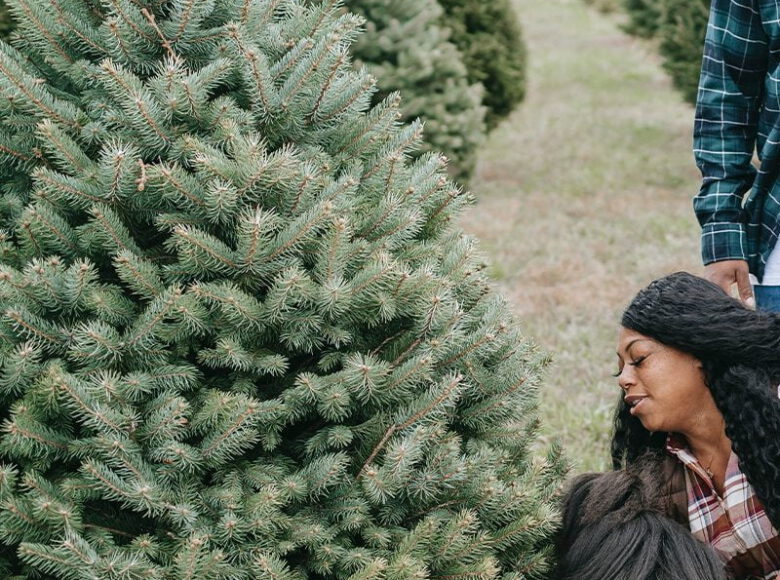Selecting the Best Live Christmas Tree
Christmas is a time filled with family, friends, food, and great memories. There are many common traditions pertaining to this time of year, such as opening presents on Christmas morning, or putting up decorations for the holidays. These two traditions have one thing in common: a Christmas tree. Picking a live Christmas tree for your family is a classic and well-loved holiday tradition. Between where to find one, colour, size and scent, there are a multitude of options for the selection process. However, don’t let the options seem intimidating. Let your friends at Safe Tree show you the right way to select your live tree, including tips for proper care and disposal.
There are several ways you can have a live tree as a Christmas tree for the holidays. For example, some people use potted trees and plant the tree in the spring. The benefit of this is that a tree is planted rather than discarded. The downfall of having a potted tree is they are significantly smaller yet heavier, tree care is trickier and proceeds for multiple months, as well as you need a location to plant it. Alternatively, if you prefer a cut tree, you can cut one down yourself, or purchase one pre-cut.
Not only is cutting your own tree a great family activity, but it allows you to support a local business and reduce the amount of fossil fuels used in transportation. Choosing a locally grown Christmas tree also reduces the risk of spreading insects and diseases. While there are strict regulations and inspections on the movement of Christmas trees to keep our forest safe – we can do our part, too! In the Niagara region, you can contact Agape Valley for pre-cut trees, or, here is a link listing many local tree farms.
The first step is choosing the right species, based on aesthetic preferences (colour, shape, texture, and fragrance). You may prefer the long needles of a pine, the sharp-needled fullness of a spruce, or a wispy softness of a fir. Some prefer blue spruce (Picea pungens) because it’s known for its blue needles, while others prefer balsam fir (Abies balsamea) for its rich green colour. Other common Christmas trees include white spruce (Picea glauca), or Fraser fir (Abies fraseri) which both have grey-whitish hues, but white spruce will have tighter branching patterns. People with children tend to select firs or pines over spruce due to their softer needles. Additionally, each type of tree has a unique fragrance, so pick a tree that has the fragrance you desire.
Once you know what species you’d like, there are a few things to consider when selecting your exact tree. Ensure that the tree stands upright, with no lean in any direction. This includes the bottom foot of the trunk; if it isn’t straight, you may have issues trying to get the tree to stand up properly on its own. When standing approximately 6ft away, the foliage should cover trunk completely, but ensure there is room between branches to add ornaments. Confirm the needles are fresh, meaning they are not brittle, dried up and/or drop easily. You should be able to gently pull on a branch (while moving your hand towards your body) from branch collar to tip without any needles falling off.
Once your tree is home, make sure you select a location that is a low-traffic area and away from heat registers. Ideally, 6 inches should be left between the tree and ceiling, or 12 inches if there is a tree topper. For example: if the ceilings in your home at 8ft tall, you should select a tree that’s 7ft tall. Furthermore, make sure you cut off the bottom inch at the stump (some farms do this upon request). A fresh cut will increase the tree’s water absorption levels, which will benefit the tree’s colour, fragrance, longevity and minimize needle drop. If you wish to further expand your knowledge, click on Christmas tree care.
When it’s time to get rid of your cut tree, there are a few options to choose from. The most common, and most convenient method is to leave your tree out with your garbage for pick up. If not, you can drop it off at a landfill, typically free of charge. We recommend an environmental approach. For example: the tree can be cut up and used as firewood and kindling, or, there are many conservation areas that will take old Christmas trees as a donation to assist with restoration projects. This keeps organic matter in the environment (which every organism benefits from) while minimizing what enters our landfill. Contact your local conservation authorities for more information.
For more information or assistance in planting your potted tree, Safe Tree has a Plant Health Care Division that could assist you.
By Kait Simpson, ISA Certified Arborist

